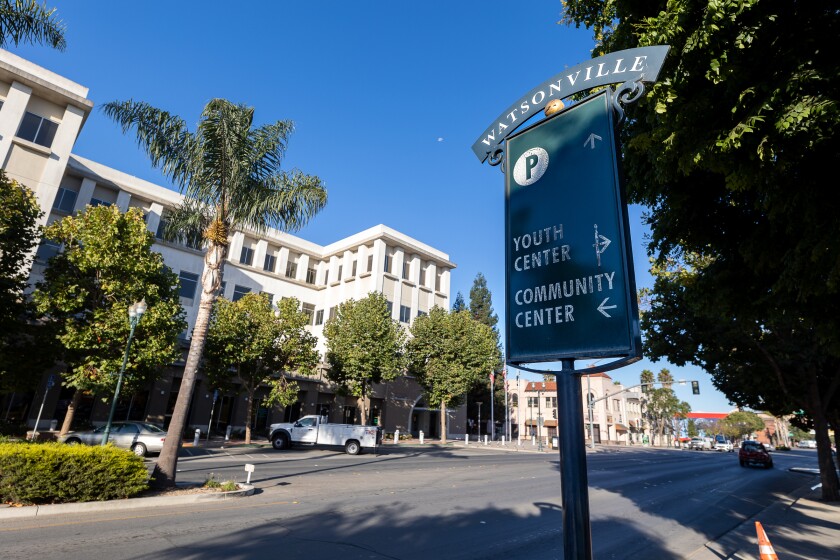The Caltrans-led “road diet” project in downtown Watsonville aims to reduce Main Street’s four lanes to two lanes with a third running down the middle and is moving as scheduled. The project is entering its environmental studies phase, but city officials want the 2031 construction date to be moved up.
Watsonville officials say they are in talks with Caltrans to move up the start date for an ambitious plan to transform the four-lane highway that runs through the city’s downtown into a pedestrian-friendly corridor, part of a broader effort to revitalize a city center that never fully recovered from a devastating earthquake more than three decades ago.
Last year, the Watsonville City Council voted unanimously to approve a 30-year vision, formally known as the Downtown Specific Plan, to revitalize the 196-acre city center which has struggled to recover its spark since the 1989 Loma Prieta earthquake damaged much of its historic core.
The plan’s most significant change is a “road diet” project — led primarily by Caltrans — that will reduce Main Street from four lanes to two with a turning lane in the center. The state agency is also working on another road project, known as the Downtown Watsonville Safety Project, aimed at creating safer conditions for pedestrians by adding curb extensions at crosswalks in downtown Watsonville.
The $25 million road diet was the result of a series of planning grants and projects the city was working on with Caltrans before it was incorporated into the Downtown Specific Plan, said Murray Fontes, Watsonville assistant public works director.
Construction isn’t expected to begin until 2031, said Fontes, though the city would like to see the construction date move up a bit: “That’s an ongoing discussion [with Caltrans].”
The project is currently entering the “environmental document” phase, according to Caltrans spokesperson Kevin Drabinski. During this phase, Caltrans will conduct environmental and traffic studies and surveys that will help planners figure out the best way to move forward while causing the least environmental harm.
Watsonville faces a challenge having a highway – Highway 152 – as its main street, said Fontes, and trying to make a road that is safe not only for cars but also for pedestrians and bicyclists isn’t easy.
“By dropping a lane of traffic, you could expand the area of sidewalk and support pedestrian amenities,” said Fontes. “Businesses could expand their seating outside to be landscaped. The tradeoff is you give up a travel lane.”
Fontes understands that some believe the road diet might make it harder for drivers to get through downtown Watsonville with only one lane in each direction, he said, but he also believes that shrinking the road will make it safer for pedestrians.
“Slowing down traffic is one of the goals of these projects,” he said. “It not only makes the community safer, but enhances the area, and in attracting people downtown, we’re hoping that will also attract businesses to follow the people.”
The city is looking at ways to manage the potential traffic congestion, including what to do if drivers cut through adjacent neighborhoods instead of taking Main Street, said Fontes. He did not specify what type of solutions the city is exploring.
Caltrans hasn’t developed any plans to manage traffic during construction yet, said Drabinski, but will be working with the city to find appropriate detours.
As for how the road diet will coincide with the city’s vision of a revitalized downtown, Fontes says it’s a chicken-and-egg scenario:
”Do the businesses come first and they encourage the local development of the public area?” he asked. “Or does the city and the state develop the public area in hopes that it will bring private development?”
The city is doing its part by making improvements to the public area, such as partnering with Caltrans to make downtown more pedestrian-friendly, in hopes that it will encourage private development to follow, he said. The city is not only trying to get residents to visit downtown, said Fontes, but also to developers, who might see it as an opportunity to invest in the area.
The City of Watsonville also received a $320,000 federal grant for active transportation, pedestrians and bicyclists, said Fontes. While unrelated to the Caltrans projects and the Downtown Specific Plan, the grant also focuses on pedestrian safety around schools, such as improving crosswalks and bike lanes, to get people out of their cars and onto their feet.
Have something to say? Lookout welcomes letters to the editor, within our policies, from readers. Guidelines here.
